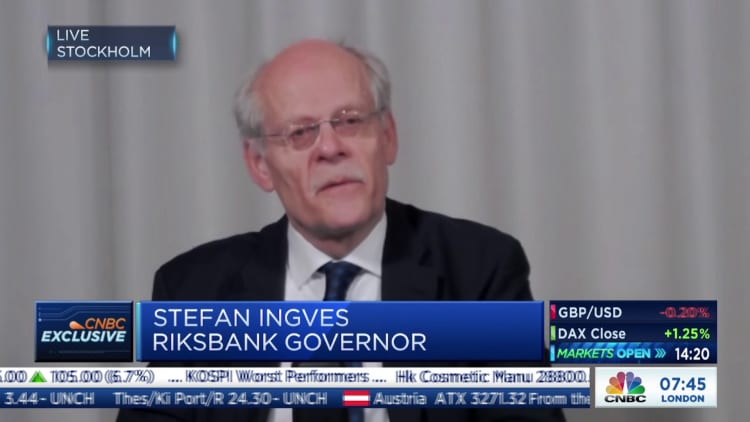[ad_1]
People in Sweden are feeling the effects of high inflation and tumbling house prices.
JONATHAN NACKSTRAND / Contributor / Getty Images
The Swedish government is now predicting a deeper than expected GDP contraction in 2023, according to data released Monday, worsening an already gloomy outlook for the country’s economy.
Sweden’s Ministry of Finance estimated in December that GDP would shrink by 0.7%, but it now predicts a 1% downturn as it reassesses the “challenging economic environment.”
“We face major challenges, but we will get through them together,” Sweden’s Minister for Finance, Elisabeth Svantesson, said in a press release Monday.
“Many people are struggling to make ends meet, so it is important for the Government to fight inflation and support those in the most difficult circumstances.”
Sweden’s government had already described the country’s economic outlook for 2023 as “gloomy” in a report in October 2022, with the expectation that the economy would slip into recession. The latest CPI data shows inflation is finally starting to slow, but wages are limping behind and house prices are facing a serious downturn.
The European Commission, the EU’s executive arm, echoed the downbeat tone in its latest growth outlook, in which Sweden is the only country where GDP growth is projected to slide into negative territory this year.
The Commission predicted a drop of 0.8% for 2023, and a gain of 1.2% in 2024, which is the second-lowest estimate after Italy. So, where is the economy faltering?
High inflation rates
Sweden’s inflation rate is starting to cool, according to core CPI data released Friday, with the headline rate for March having fallen to 8% compared to 9.4% in the previous month, but the figure remains well above the central bank’s target rate of 2%.
While March’s CPI data is a sign inflation is moving in the right direction, Swedish households are unlikely to get much reprieve from the figures.
“People have lower purchasing power than they’ve had for a number of years … So many people struggle with basic things and also cut down on their consumption,” Ola Olsson, professor of economics and vice dean at the School of Business, Economics and Law at the University of Gothenburg, told CNBC before the inflation figures were released.
The National Institute of Economic Research said last month that it expects inflation — excluding energy — to remain high throughout the year, and it will take until the second quarter of 2024 before it finally comes down below 2%.
The Swedish think tank also warned it would take until 2025 before the economy clearly turns upward and an expected recession may now not be assumed to have ended until 2026.
Expenses for homeowners have seen a sharp increase since 2020, according to the Homeowners Index by comparison service Zmarta. Housing expenses, which include costs involving the house and its plots such as electricity and water, tax and interest costs, currently come to 206,039 Swedish krona ($20,000) per year, compared to 116,483 per year as calculated in the first half of 2020.
The inflation figure is also unlikely to impact the central bank’s interest rate hiking cycle, which unexpectedly started in April last year, according to Swedbank.
“We maintain after [Friday’s] data that the Riksbank will hike by 50 basis points [on April 26],” the bank said in a note.
Eroding real wages
Most European countries are experiencing sky-high inflation, leaving real wages lagging behind. In Sweden, a new two-year wage agreement puts the benchmark increase in real pay at 4.1% for 2023 and 3.3% in 2024 – well below even the latest, slightly lower, inflation rate.
Jens Magnusson, chief economist of Swedish bank SEB, told CNBC the figures give the Riksbank more time to tame inflation, but they mean Swedish people are losing around six to eight years of real income growth with the new agreement.
“Households are pressured and we do see that the interest rate hikes have yet to have their full effect on households,” he added.
The pressure on household income has prompted pay-related strikes across parts of Europe – but not in Sweden, where people accept real wage decline as an inevitability, according to Olsson.
“There’s been a great acceptance … among people who work that we must have real wage decline this year because otherwise it will be like a wage-price spiral that can get out of hand, which we had in the seventies,” Olsson said.
Plummeting house prices
Swedish house prices have long been some of the strongest in Europe, but Stefan Ingves, who headed the country’s central bank from 2006 to 2022, has previously warned the country will face its “day of reckoning” thanks to a “dysfunctional” system.

House prices then defied economists’ expectations when they experienced a second consecutive monthly uptick in March, according to Svensk Maklarstatistik data, but analysts have warned that a further downturn is still on the horizon.
“We’re quite surprised by the unchanged price development [at] the beginning of the year in non-adjusted figures … I would call this a false dawn,” Gustav Helgesson, an analyst at Nordea, told CNBC before the latest house price data from Svensk Maklarstatistik was released.
“We’re not out of the woods,” he added.
Danske Bank recently revised its previous estimate of a 20% drop in real house prices, peak to trough, to a 25% drop. Prices are currently down by 12% from the peak recorded in February 2022, according to Danske, leaving prices “still only half-way to the bottom.”
[ad_2]

